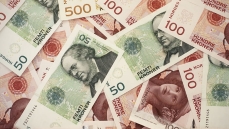Trading Norwegian Krone
The Norwegian Krone, sometimes known as the Kroner, which is directly translated as “crown”, is the official legal tender of Norway. It is not used in any other country worldwide, and its Forex code is NOK. Despite the small size of Norway’s currency it is still traded quite frequently, its commonest currency pairing being with the US Dollar. The economy of Norway has a large budget surplus, and this has led some people to consider the Krone as a safe-haven currency, although another school of thought has suggested that Norway is too small for its currency to be a viable alternative to major international currencies like US Dollars, Swiss Francs or Euro. The Norwegian Krone is regulated by the country’s central bank, known as the Norges Bank. This organisation is responsible for setting monetary policies and interest rates in order to pursue a stable and low level of inflation. Although Forex trading with the Krone is relatively popular, it can be quite a risky choice of currency due to the strong influence on its value from shifts in oil prices.
| Broker | Bonus | More |
|---|
Historical Facts Behind the Norwegian Krone
The Norwegian Krone was first issued in 1875, and replaced the previous currency, which was known as the Norwegian Speciedaler. At the same time, the country became part of the Scandinavian Monetary Union, a body which had been established 2 years earlier, and which continued to exist until 1914. The three countries that were part of this union, Denmark, Sweden and Norway, each chose to retain the name Krone for their respective currencies, even when the Union had been dissolved at the outbreak of the First World War. However, the currencies have been separate ever since that time.
The Norwegian Krone was kept on the Gold Standard whilst it was part of the Scandinavian Monetary Union, and this standard was once more restored during the period 1916 to 1929, and once more in 1928; however, it was permanently suspended in 1931 as the currency was then pegged to the British Pound Sterling. This was changed in 1939 when Norway’s Krone was pegged to the US Dollar temporarily, and then again from 1940 to 1945 when the currency was pegged to the Reichsmark during the period of the German Occupation. Norway’s central bank decided to abandon its fixed exchange rate in 1992, and established a floating exchange rate. This was due to a large amount of speculation against the currency in the early part of the decade, which had resulted in a loss of about 2 billion Kroner for the central bank.
Norway’s Economic Outlook

Since the oil boom in the 1970s, Norway’s government has put little effort into the development and encouragement of any new private-sector industries, which is in stark contrast to some of the other Nordic countries such as Finland and Sweden. However in recent years, more incentives are now forthcoming from both the national and local government to help encourage the development of other industries within the country that can compete on an international scale. As part of these incentives, there have been movements towards high-tech industries and biotechnology.
Factors Influencing the Economy of Norway
The exchange rate of the Norwegian Krone is strongly influenced by the price of oil due to Norway’s heavy reliance on the petroleum producing sector. Any fall in the global price of oil will necessarily impact on the value of Norway’s currency itself, and conversely any rise will boost the nation’s economy. Another factor that comes into play with regard to Norway’s economy is turbulence in the international financial market. As the Krone is thought of as a peripheral currency, when there is high volatility in the market many international traders reduce the amount of Krone that they trade, which leads to a depreciation of the currency.


